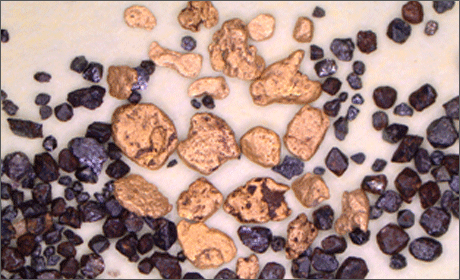Sperrin Mountains, Northern Ireland
Sperrin Mountains gold mine: © Dalradian Gold
Discovery of gold in the Sperrin Mountains followed geological and geochemical surveys conducted by the Geological Survey of Northern Ireland (GSNI) in the 1970s. Over the last four decades there has been much geological mapping and research by the GSNI, academics and industry, aimed towards understanding why and where the gold is present. Gold mineralisation in this region is now known to have occurred as a consequence of mountain building processes and is referred to as ‘orogenic’ in nature. Currently there are two economically viable deposits in the Sperrin Mountains, and since 2007, Northern Ireland has been home to the only gold mine in the UK.
In the Sperrin Mountains, gold is found with pyrite (fool’s gold) in quartz veins within metamorphic host rocks. The host rocks, broadly known as schists, are
| |

|
| |
Gold deposits: © Dalradian Gold
|
collectively referred to as the Dalradian Supergroup and are Precambrian in age, so about 650 to 600 million years old. The veins range from a few millimetres to several metres in width, and were formed by later earth movements, or tectonism, that created space for high temperature mineralising fluids to fill.
The majority of gold mineralisation in the region took place during the Ordovician time period, around 465 million years ago, as an ancient ocean called Iapetus began to close. This initial closure brought lines (or arcs) of volcanoes and slabs of ocean crust into collision with the continental margin where the host rocks where sitting. This orogenic collision, known as the Grampian Orogeny (an early phase of the Caledonian orogeny), resulted in rapid thickening of the crust and saw huge increases in temperature and pressure which cause regional metamorphism, and ultimately the gold mineralisation. There is continued debate and research aimed towards unveiling the role of later tectonic events in gold mineralisation across the region, and there is no doubt that earth movements during the Devonian and Carboniferous time periods, between 400 and 300 million years ago, known as the Variscan Orogeny, have modified and complicated the rocks and gold deposits.
Twinned with: Sierra Nevada, California
The Sierra Nevada is a mountain range in California and Nevada and forms part of the North American Cordillera, a chain of mountains that extends down the west coast of North America. The Sierra Nevada foothills are famous for their high concentrations of gold. They are host to ...continue reading